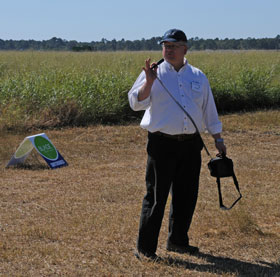 A school bus in Michigan has just hit 300,000 miles, and the bulk of those miles have come while running on biodiesel.
A school bus in Michigan has just hit 300,000 miles, and the bulk of those miles have come while running on biodiesel.
This National Biodiesel Board press release tells the tale of Bus #14 of the St. Johns, Michigan Public School system, which started burning a 20 percent blend five years ago:
“Since switching to biodiesel, it is much cleaner and smells much better,” the 20-year veteran of the St. Johns, Mich. Public Schools said. “When fueling, you don’t have the smell on your hands all day. Your clothes don’t smell like diesel all day. It is a much better work environment and much healthier for the kids and the community.”
The school district’s switch to B20 in 2002 came from the persistence of Wayne Hettler, Garage Foreman & Head Mechanic for St. Johns. His foresight has led to a reported track record of bus longevity and reduced service needs, saving the school district money.
Last week, “bus #14” rolled over 300,000 miles – a milestone Hettler attributes to B20 and believes no other Michigan school bus used on a daily route has achieved.
In October, 2002, bus #14 had 119,621 miles on the odometer. That was the first day of the rest of its life on B20. Since then, the maintenance on this engine has been very low with the only unscheduled maintenance being a $160 lift pump and a $90 injector, according to Hettler.
St. Johns officials add that due to the extra lubricity biodiesel brings to the table, the school district has been able to extend the mileage between oil changes from about every 6,000 miles to 12,000-18,000 miles, saving the district money on oil and filters. The district figures it has driven 3 million miles on B20.
The program hit a bit of a snag when rising biodiesel costs forced school officials to cut to B5, but they hope that they’ll be able to go back to B20 soon.
 Students across the country recently had a chance to have a blast with biofuels. The 4-H National Youth Science Day taught kids some of the basics of the green fuels.
Students across the country recently had a chance to have a blast with biofuels. The 4-H National Youth Science Day taught kids some of the basics of the green fuels. With a little sugar, water, yeast, and a balloon, kids watched how yeast breaks down sugars.
With a little sugar, water, yeast, and a balloon, kids watched how yeast breaks down sugars.

 The
The  California-based
California-based  The Science magazine article that was published last week and co-authored by Tim Searchinger, a lawyer, has added another level of controversy to the indirect land use change (ILUC) debate. The article suggested the land use effects of fuel produced from various forms of biomass were miscalculated, in part, because they cause deforestation around the world as land is cleared to grow so called “energy crops”. EPA has yet to rule on RFS2 (
The Science magazine article that was published last week and co-authored by Tim Searchinger, a lawyer, has added another level of controversy to the indirect land use change (ILUC) debate. The article suggested the land use effects of fuel produced from various forms of biomass were miscalculated, in part, because they cause deforestation around the world as land is cleared to grow so called “energy crops”. EPA has yet to rule on RFS2 ( The
The  We’ve certainly heard a lot about switchgrass as a biomass option for the production of ethanol. How many of you have seen it growing?
We’ve certainly heard a lot about switchgrass as a biomass option for the production of ethanol. How many of you have seen it growing? Switchgrass is native to the United States everywhere east of the Rockies. Ceres, has been working on varieties that will yield better in different growing environments though. Cory says that they don’t expect it to displace corn in Iowa but in the southeast with the difficulties in cotton and tobacco it becomes a viable alternative on open acres. He provides some estimates of what the crop can mean financially as the market for a fuel crop like switchgrass develops.
Switchgrass is native to the United States everywhere east of the Rockies. Ceres, has been working on varieties that will yield better in different growing environments though. Cory says that they don’t expect it to displace corn in Iowa but in the southeast with the difficulties in cotton and tobacco it becomes a viable alternative on open acres. He provides some estimates of what the crop can mean financially as the market for a fuel crop like switchgrass develops. “We’re excited about this initiative because it’s a win for consumers, farmers, retailers and ethanol producers,” said Gov. John Hoeven, during a Friday news conference announcing the state Department of Commerce Biofuels Blender Pump incentive program.
“We’re excited about this initiative because it’s a win for consumers, farmers, retailers and ethanol producers,” said Gov. John Hoeven, during a Friday news conference announcing the state Department of Commerce Biofuels Blender Pump incentive program. Dallas-based Evolution Fuels, Inc. has announced a plan to put the biodiesel it produces in five of its own truck stops.
Dallas-based Evolution Fuels, Inc. has announced a plan to put the biodiesel it produces in five of its own truck stops. A school bus in Michigan has just hit 300,000 miles, and the bulk of those miles have come while running on biodiesel.
A school bus in Michigan has just hit 300,000 miles, and the bulk of those miles have come while running on biodiesel. Coming to Omaha, Nebraska on November 10-12, the Operators’ School is designed to educate ethanol producers on the ins and outs of alcohol production, the latest troubleshooting techniques and technology used in the industry. The three day conference will be held at Scott Conference Center at 6450 Pine Street.
Coming to Omaha, Nebraska on November 10-12, the Operators’ School is designed to educate ethanol producers on the ins and outs of alcohol production, the latest troubleshooting techniques and technology used in the industry. The three day conference will be held at Scott Conference Center at 6450 Pine Street.